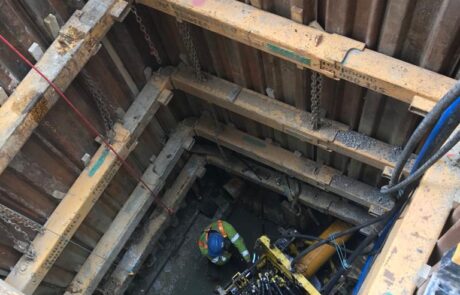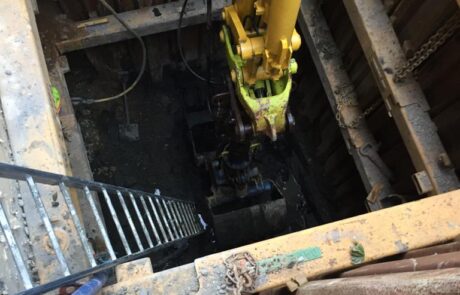Description: Falco was appointed to construct a new 16 metre DN 225 sewer connection – 5.5m deep using no-dig techniques with a DN1200 demarcation manhole (also 5.5m deep).
The works were located directly adjacent to an elevated section of the Docklands Light Railway (DLR) so a robust methodology for operating lifting equipment was agreed with stakeholders to eliminate risks of accidental impact with DLR infrastructure which included electronic slew & height parameters programmed into the control systems of lifting equipment.
A Section 106 Consent to connect to the Thames Water sewer had been obtained by the clients’ civil engineering designer. As part of our construction phase duties, we engaged with Thames Water operational teams to obtain the necessary safety permits. During our initial discussions two practical issues quickly emerged: When our confined spaces sewer survey team carried out the man-entry condition survey of the receiving Thames Water sewer we found substantial fibre-optic telecoms cables installed in the sewer clashing with the proposed new connection point. A diversion of which would entail significant time /cost implications. Also, the receiving sewer was confirmed to be a trunk sewer and Thames Water do not permit direct connections to trunk sewers as a matter of policy.
Leveraging our network of contacts from the various Thames Water Departments, and by revising the construction methodology, Falco were able to present an alternative solution that avoided the fibre optic cables and identified good engineering reasons for granting a waiver to the strict policy on direct connections to trunk sewers. Bespoke temporary works designed by Fairhurst were developed to BS5975 and installed by Falco specialist deep excavation teams.
Quality was managed via an Inspection & Test Plan agreed in advance with Laing O’Rourke with key hold-points built into the programme. As a key stakeholder, Thames Water were issued with photographic and test records of the connection works affecting their assets. All test records and certificates of conformity were submitted to the Principal Contractor for incorporation into the Health & Safety File.









